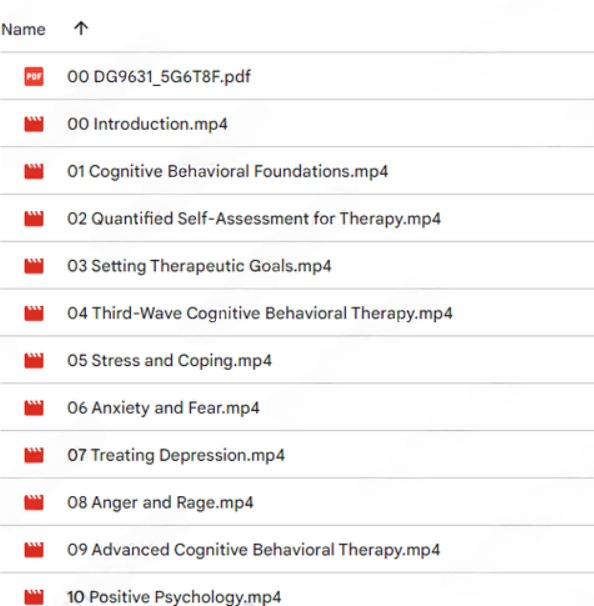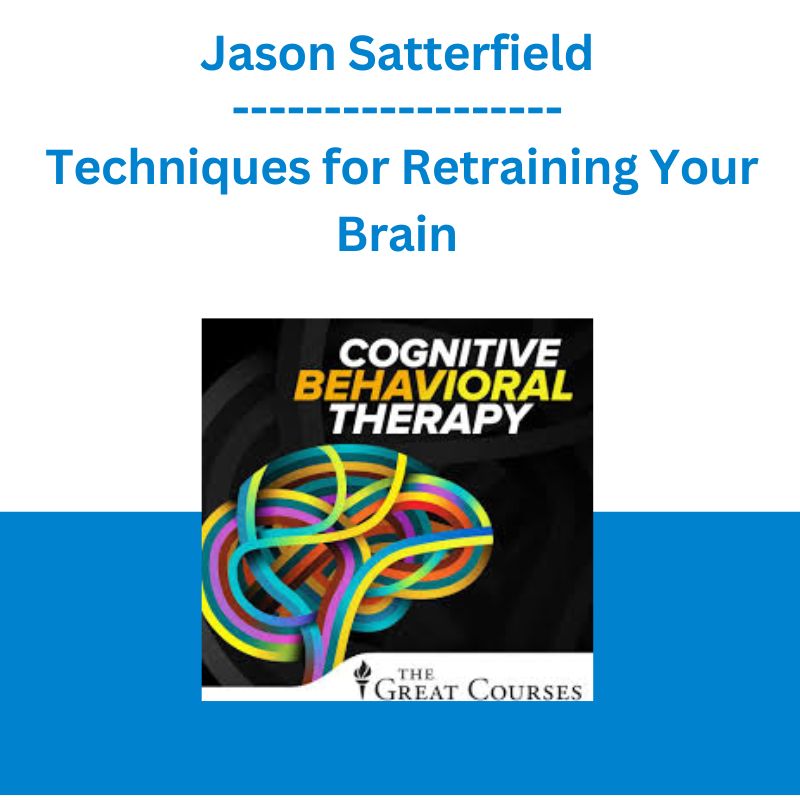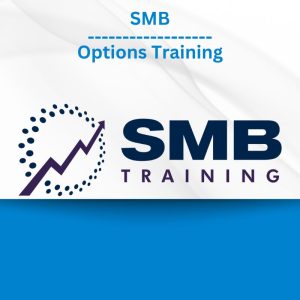*** Proof of Product ***

Exploring the Essential Features of “Cognitive Behavioral Therapy: Techniques for Retraining Your Brain – Jason Satterfield”
Cognitive Behavioral Therapy: Techniques for Retraining Your Brain
Discover practical techniques for modifying undesirable behavior and managing your moods with this course that explains how and why cognitive behavioral therapy works.
LESSON
Trailer
01:Cognitive Behavioral Foundations
Begin by meeting Dr. Satterfield’s patients-Carol, Michael, and Maria-each with something in their lives that could be helped with cognitive behavioral therapy (CBT). You will follow these patients throughout the course as you learn the basics of CBT, including how you can train your brain to improve motivation, management of emotions, and interpersonal skills….
33 min
02:Quantified Self-Assessment for Therapy
Trace the roots of CBT and see how it upends the typical psychoanalysis process, focusing on daily events and emotions instead of past history. Watch as Dr. Satterfield performs an initial assessment of three new patients, helps them set SMART goals, and begins to collect data about their thoughts, emotions, and actions….
32 min
03:Setting Therapeutic Goals
A fascinating aspect of CBT is the collaborative journey the therapist and patient take to create the patient’s case formulation, a living document that serves as a basis for an individual treatment plan and guides the therapy process. Watch as the doctor helps Michael unpack his anger to understand why certain situations make him furious….
30 min
04:Third-Wave Cognitive Behavioral Therapy
Now that you are familiar with the basics of CBT, explore the third wave, which focuses on the process of cognition rather than its content. It’s been described as Buddhist meditation meets CBT, and the research shows some surprising results!…
32 min
05:Stress and Coping
Alleviate stress by learning how to quiet the two primary physiological stress pathways: one secretes the stress hormone called cortisol, and the other secretes epinephrine or adrenaline (often called the fight or flight response). See how CBT helps you examine your preferred coping styles to determine whether or not you’re selecting the best adaptive strategies for you….
32 min
06:Anxiety and Fear
Contrast the emotions of anxiety and fear, and consider how each can feed the other. Use the SUDS hierarchy to perform a thorough analysis of situations that induce these feelings, then see how behavioral experiments can systematically desensitize you to the things you once feared or avoided….
29 min
07:Treating Depression
Identify the nine hallmark symptoms of depression, then use the CBT triangle to describe the three downward spirals that contribute to a depressive episode. Observe as Dr. Satterfield walks Maria through tools to help her alleviate her depression, and learn how you can apply these same techniques to lift your mood….
34 min
08:Anger and Rage
Delve into the surprising root of many anger issues and see how CBT works to decrease “hostile fantasies,” or the thoughts you have when a person or situation triggers your anger. Add simple exercises to your life that will help you recognize triggers and defuse them before they become full-blown rage….
32 min
09:Advanced Cognitive Behavioral Therapy
Progress from basic cognitive restructuring to an in-depth look at a tool that helps build awareness of the thoughts and emotions you have in a particular situation. See how the collaborative problem solving in CBT creates flexibility and the creativity to find something that works for each individual person, given his or her life circumstances….
30 min
10:Positive Psychology
Although CBT was developed for the treatment of psychopathology and negative mood states, it has more recently been used as a way to encourage or induce positive emotion. Explore recent scientific studies about happiness, and learn which exercises are most effective for cultivating improved mood….
29 min
11:Healing Traumatic Injuries
Define the various types of trauma that can affect people-from combat veterans suffering from PTSD to victims of random violence-and learn how CBT can be used to treat these patients with great success. See how the tools used in CBT sessions help to unstick the brain and begin the process of repairing damage….
30 min
12:Forgiveness and Letting Go
Forgiveness-and its associated health benefits-begins with a cognitive decision and can be promoted with both cognitive and behavioral strategies. Delve into the fascinating scientific research on forgiveness, identify maladaptive strategies that are holding you back, and create an A.C.T.I.O.N. plan….
31 min
13:Digging Deep and Finding Meaning
Move beyond searching for explanations for why painful events happened, instead turning your thoughts to what those events mean in your broader perspective and how your reactions can be intentionally shaped using CBT. See how CBT can provide tools to support positive shifts in perspective and help you see the bigger picture….
29 min
14:Cognitive Behavioral Therapy and Medicine
Recently, there has been growing acceptance of CBT as part of the treatment for medical illnesses, from diabetes to cardiovascular disease to cancer. Discover the pivotal role that cognitions and emotions can play in empowering patients and helping them manage their physical maladies….
30 min
15:Staying on the Wagon
Whether you want to lose weight, quit smoking, or exercise more, learn the secrets to creating habits that stick. Identify and define core concepts, such as self-control, self-discipline, motivation, and willpower, and see how each of these can be affected by the CBT skills you’ve learned in previous lectures….
31 min
16:Thinking Healthy: Weight and Nutrition
Yo-yo no more: Patients who used CBT to manage their relationship with food and exercise showed decreased weight, decreased body mass index, decreased waist circumference, and improved eating habits. Use the core behavior change principles from previous lectures and apply them to healthy eating and exercise habits….
31 min
17:Behavioral Therapy for Chemical Addictions
Review the basics of substance use disorders-alcohol, prescription drugs, and illegal drugs-and what second- or third-wave CBT therapies can offer people who suffer with addiction. Add community reinforcement approach (CRA) to your CBT toolkit and see how it can be more successful than 12-step recovery programs….
32 min
18:Getting a Good Night’s Sleep
Fewer than half of Americans say they get a good night’s sleep on most nights. Observe as Dr. Satterfield works with Maria to assess her quality and quantity of sleep. Apply the techniques of CBTI (the “I” is for insomnia) to fall asleep faster and wake more rested….
32 min
19:Mastering Chronic Pain
Both cognitive and behavioral factors influence the experience of pain and the intensity of suffering. Learn how psychological factors can alter the experience of pain, look at mind-body factors that can alleviate or exacerbate chronic pain, and take out the CBT toolbox to see how it can be applied to physical, rather than emotional, hurt….
31 min
20:Building and Deepening Relationships
Relationships are vital to our health and happiness. Explore the intricate world of human relationships, study the unwritten rules of social interactions, and discover how CBT can help you think through difficult situations without letting your emotions get the best of you….
32 min
21:Constructive Conflict and Fighting Fair
Go beyond the one-on-one therapist-patient scenario and look at CBT’s approach to couples’ therapy, focusing on communication, conflict, empathy, respect, and intimacy. Meet Michael’s wife as she joins her husband in Dr. Satterfield’s office to talk about Michael’s anger and their relationship….
32 min
22:Thriving at Work through Behavioral Health
Problems at work are more strongly associated with health complaints than any other life stressors. Examine best-selling books like The 7 Habits of Highly Effective People and How to Win Friends and Influence People and see where they line up neatly with CBT-and where CBT offers a better way to achieve success and happiness in the workplace….
33 min
23:Developing Emotional Flexibility
Peer into the lives of people who have thrived in the face of adversity-why do some people flower while others wilt? The keys to flourishing are flexibility and resilience. Complete your CBT toolkit with a list of ten ways that you can develop and sustain personal resilience….
31 min
24:Finding the Best Help
Round out the course with a look at Carol, Maria, and Michael’s progress. Then, Dr. Satterfield gives you his personal recommendations for finding a quality therapist, making the most of your sessions, evaluating your progress, and knowing when to end your therapy sessions….
38 min
DETAILS
Overview
Everyone has something about their life that they would like to improve. Cognitive Behavioral Therapy is a scientific, logical approach that investigates well-tested, practical techniques to assess your situation and select appropriate tools for change. Become aware of your daily thoughts, manage moods, and modify undesirable behaviors. Take steps toward gradual, lasting, goal-oriented change.
About
Jason M. Satterfield
Doing a comprehensive course on mind-body medicine has been a lifelong dream. We can all manage our health and alter our environments. Next up: cognitive therapy tools that can improve health and wellness. Onward and upward!
Professor Jason M. Satterfield is Professor of Clinical Medicine, Director of Social and Behavioral Sciences, and Director of Behavioral Medicine in the Division of General Internal Medicine at the University of California, San Francisco (UCSF). He earned his B.S. in Brain Sciences from the Massachusetts Institute of Technology and his Ph.D. in Clinical Psychology from the University of Pennsylvania. He currently directs the UCSF Behavioral Medicine Unit, which integrates mental and behavioral health services into adult primary care. Professor Satterfield’s book, A Cognitive-Behavioral Approach to the Beginning of the End of Life: Minding the Body, was recognized as a Self-Help Book of Merit by the Association for Behavioral and Cognitive Therapies. He served on the Behavioral and Social Science Subcommittee that revised the Medical College Admission Test-work that was recently featured in the New England Journal of Medicine and The New York Times. Professor Satterfield is also part of a core interdisciplinary team that is writing a medical textbook based on the biopsychosocial model. He has been nominated for multiple teaching awards at UCSF, and he is often competitively selected to teach at national conferences for a wide variety of health professionals, including physicians, nurses, social workers, and psychologists.
REVIEWS
LPMx
This book is amazing
I have listened and re-played this book multiple times on Audible. There are so many examples in this book that can help you to not only accept but appreciate certain aspects of your life – as Dr Satterfield him says in the beginning. Be patient with the book, replay chapters if they seem confusing. Highly recommended!
Divaqueen
Cognitive Behavioral Therapy
Dr Satterfield is kind amazing and very educated. He educated me regarding my chronic pain and to use modalities in my toolbox to combat the pain every single day. I’ve also learned that is OK not to be OK on any given day. I will probably go back and revisit this course at some point thank you again Dr. Satterfield you are truly amazing.
Please see the full list of alternative group-buy courses available here: https://lunacourse.com/shop/









